The adult male moth has feathery (plumed) antennae that are so sensitive they can "smell" a female a mile away. His body can be light beige to dark brown with black jagged bands on brown forewings. His wingspread ranges from only ¾ to 1½ inches, he is a strong flyer and capable of mating with several females. Adult moths are typically active from late summer through early fall.
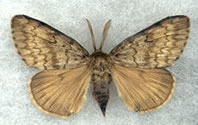 Adult Male
Adult Male
The adult male moth has feathery (plumed) antennae that are so sensitive they can "smell" a female a mile away. His body can be light beige to dark brown with black jagged bands on brown forewings. His wingspread ranges from only ¾ to 1½ inches, he is a strong flyer and capable of mating with several females. Adult moths are typically active from late summer through early fall.
 Adult Male
Adult Male
It is still rare to find spongy moth in Minnesota, usually the only way they are detected is when lured into survey traps. Other species more commonly found in Minnesota, such as the Forest and Eastern Tent Caterpillars, can be similar-looking to spongy moth.
Spongy moth eggs are laid in a fuzzy, tan-colored mass. The egg mass contains 500-1,000 eggs and is about the size of a quarter. Eggs are laid during late summer and hatch the following spring. Egg masses can be found on both living and inanimate objects, including:
- nursery stock
- logs
- roof eaves
- wheel wells
- firewood
- lawn chairs
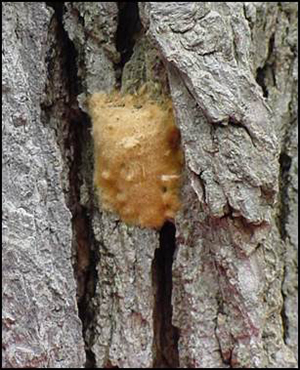 Egg mass
Egg mass
This is the life stage that is most likely to be transported by humans.
The caterpillar hatches from the egg and grows to a length of 2½ inches as it matures. Its body is covered with hairs to protect it from predators. Along its back, the caterpillar has five pairs of blue spots near the head followed by six pairs of red spots. It actively feeds on plant foliage from late spring through mid-summer.
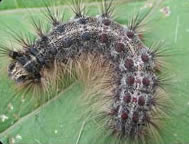 Caterpillar (larva)
Caterpillar (larva)The pupa is an immobile stage of this insect's life. Though it appears inactive, it is very busy inside transforming from a caterpillar into an adult moth. Found during mid-summer, it is dark reddish-brown, leathery in appearance, and often tethered to an object with silk strands. Pupae can range in size from ¾ inch to 1½ inches long.
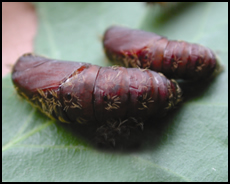 Pupa
Pupa
The adult female moth is white with brown jagged markings on her wings. Her wingspread ranges from 1 to 2 inches, but she cannot fly. Female spongy moth attracts males by releasing a pungent sex attractant (pheromone). After attracting a male and successfully mating the female lays a single egg mass and dies. Adult moths are typically active from late summer through early fall.
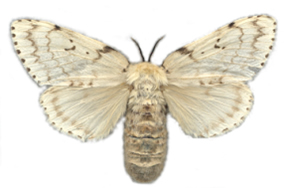 Adult Female
Adult Female
The adult male moth has feathery (plumed) antennae that are so sensitive they can "smell" a female a mile away. His body can be light beige to dark brown with black jagged bands on brown forewings. His wingspread ranges from only ¾ to 1½ inches, he is a strong flyer and capable of mating with several females. Adult moths are typically active from late summer through early fall.
 Adult Male
Adult Male
Smarty Plants Podcast
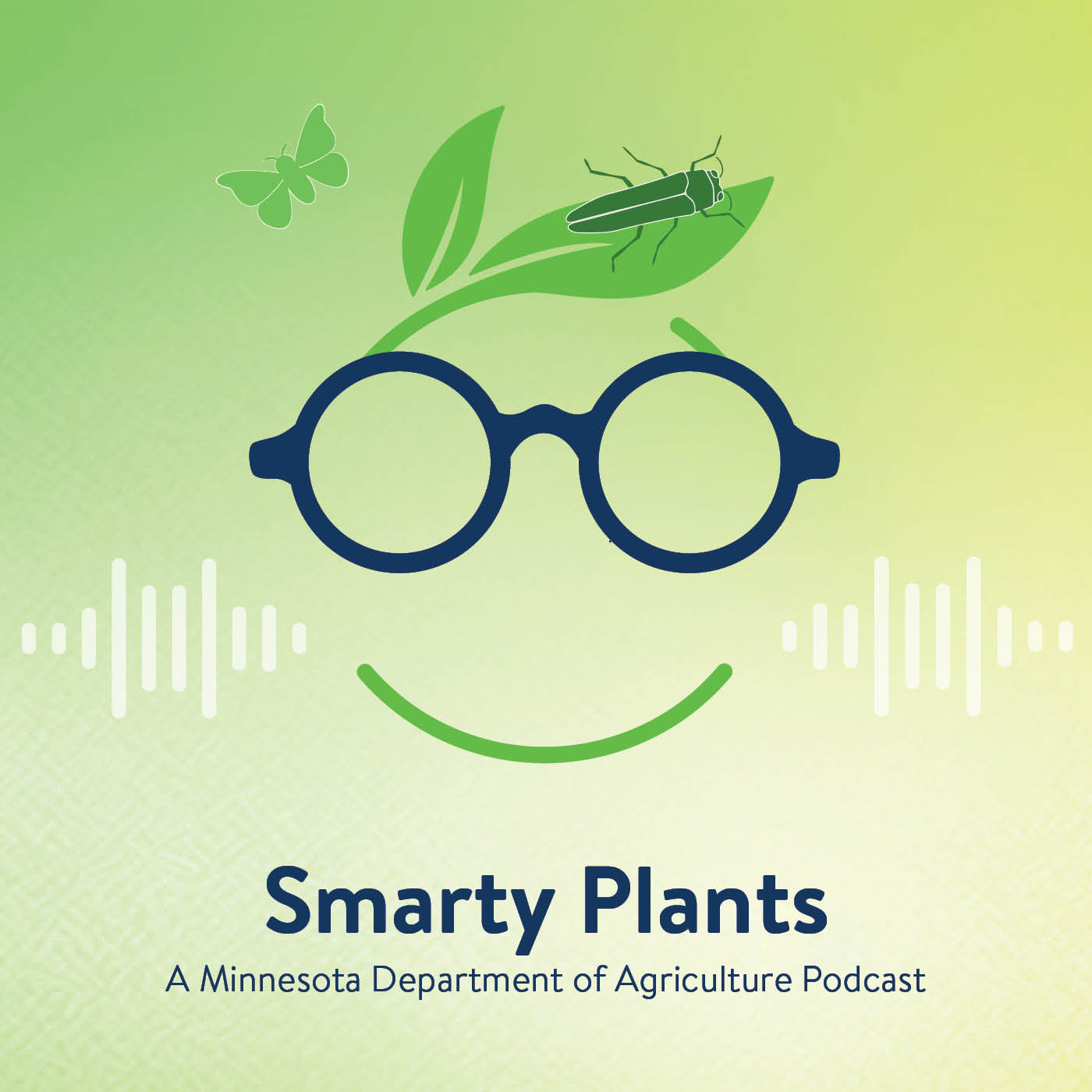 Discover Smarty Plants, the Minnesota Department of Agriculture's podcast that digs into the fascinating world of invasive species. Join expert guests as they share insights and solutions to protect our environment and agricultural resources. Visit Smarty Plants and start listening today.
Discover Smarty Plants, the Minnesota Department of Agriculture's podcast that digs into the fascinating world of invasive species. Join expert guests as they share insights and solutions to protect our environment and agricultural resources. Visit Smarty Plants and start listening today.
Introduce cover crops into the cropping system. Cover crops are grasses, legumes, or forbs planted for seasonal vegetative cover, established on an annual basis, between successive cash crops or companion-planted into a cash crop. Cover crops often get planted in fields following a short season crop or other times when a field would otherwise have little or no vegetative cover. Cover crops can be established between growing seasons to protect the soil from erosion and nutrient loss.
A primary purpose of cover crops is to capture left-over nutrients, like nitrate-nitrogen in the soil. Other purposes may include forage production, erosion reduction, suppression of weeds or pests, improvement of soil moisture use efficiency, or overall soil health improvement.
The amount of nitrate leaching reduction from cover crops varies depending on many factors, mainly weather and biomass accumulation of the cover crop in the fall. Despite their variability, research has shown that cover crops provide a nitrate reduction compared to no cover crops. Studies in Minnesota and Iowa have shown reductions in nitrate loads in drainage water between 11% and 76% with rye cover crop.
Requirements to qualify for Cover Crop Initiative funding:
- Work with MDA field staff, local Soil and Water Conservation District (SWCD), Natural resources Conservation Services (NRCS) technician, agronomist, or other natural resource professional to plan, develop, and design a cover crop program based on adoption of species that have a very good or excellent ability to scavenge nitrogen. Inclusion of cover crops into a cropping system involves unique management strategies. Please refer to MDA’s Minnesota Cover Crop Guide, the Midwest Cover Crops Council, or NRCS MN Agronomy Tech Note 33 for information on cover crop species, seeding date, seeding rate, method of seeding, etc.
- Work with a local SWCD and enroll in their cover crop program, if possible.
- Funding through this initiative may be available for producers operating in a Level 2 DWSMA who choose to go above and beyond a local county/SWCD, state, or federal cover crop program. For example: additional or different acres may be funded through this initiative than those acres enrolled in a publicly funded local SWCD, Federal Farm Bill, Minnesota Ag Water Quality Certification Program (MAWQCP), or other state cost share program.
- Producers cannot participate in another publicly funded cover crop cost share program on a county, state, or federal level on the same acres enrolled in this initiative. For example: producers participating in a Federal Farm Bill Cost-share program, MAWQCP cover crop program, or other state of Minnesota cover crop program, or local county/SWCD cover crop program are ineligible to enroll the same acres from the publicly funded program into this initiative.
Producer Compensation
Producers who enroll in the Cover Crop Initiative may be eligible for compensation based on meeting the components in the technical resources mentioned above. Producers may be eligible for a payment of $40/acre up to 125 acres for a maximum of $5,000. Payment to producer will be made upon successful establishment of cover crop.
Introduce cover crops into the cropping system. Cover crops are grasses, legumes, or forbs planted for seasonal vegetative cover, established on an annual basis, between successive cash crops or companion-planted into a cash crop. Cover crops often get planted in fields following a short season crop or other times when a field would otherwise have little or no vegetative cover. Cover crops can be established between growing seasons to protect the soil from erosion and nutrient loss.
A primary purpose of cover crops is to capture left-over nutrients, like nitrate-nitrogen in the soil. Other purposes may include forage production, erosion reduction, suppression of weeds or pests, improvement of soil moisture use efficiency, or overall soil health improvement.
The amount of nitrate leaching reduction from cover crops varies depending on many factors, mainly weather and biomass accumulation of the cover crop in the fall. Despite their variability, research has shown that cover crops provide a nitrate reduction compared to no cover crops. Studies in Minnesota and Iowa have shown reductions in nitrate loads in drainage water between 11% and 76% with rye cover crop.
Requirements to qualify for Cover Crop Initiative funding:
- Work with MDA field staff, local Soil and Water Conservation District (SWCD), Natural resources Conservation Services (NRCS) technician, agronomist, or other natural resource professional to plan, develop, and design a cover crop program based on adoption of species that have a very good or excellent ability to scavenge nitrogen. Inclusion of cover crops into a cropping system involves unique management strategies. Please refer to MDA’s Minnesota Cover Crop Guide, the Midwest Cover Crops Council, or NRCS MN Agronomy Tech Note 33 for information on cover crop species, seeding date, seeding rate, method of seeding, etc.
- Work with a local SWCD and enroll in their cover crop program, if possible.
- Funding through this initiative may be available for producers operating in a Level 2 DWSMA who choose to go above and beyond a local county/SWCD, state, or federal cover crop program. For example: additional or different acres may be funded through this initiative than those acres enrolled in a publicly funded local SWCD, Federal Farm Bill, Minnesota Ag Water Quality Certification Program (MAWQCP), or other state cost share program.
- Producers cannot participate in another publicly funded cover crop cost share program on a county, state, or federal level on the same acres enrolled in this initiative. For example: producers participating in a Federal Farm Bill Cost-share program, MAWQCP cover crop program, or other state of Minnesota cover crop program, or local county/SWCD cover crop program are ineligible to enroll the same acres from the publicly funded program into this initiative.
Producer Compensation
Producers who enroll in the Cover Crop Initiative may be eligible for compensation based on meeting the components in the technical resources mentioned above. Producers may be eligible for a payment of $40/acre up to 125 acres for a maximum of $5,000. Payment to producer will be made upon successful establishment of cover crop.
Terminate fall seeded cereal grain cover crops the following spring after the cover crop has reached twelve inches in height or after May 13. Delayed cover crop termination, especially with fall-seeded winter cereal grains, has been shown to increase nitrogen retention, thereby reducing nitrate-nitrogen leaching though the soil profile.
Requirements to qualify for Delayed Cover Crop Termination Initiative funding:
- Terminate fall seeded, winter-hardy cover crops the following spring.
- (1) Either plant cash crop into standing, green cover crop and terminate after May 13 or after cover crop has reached 12” in height. Or (2) Terminate cover crop after May 13 or after it has reached 12” in height and plant cash crop later.
- Provide records of cover crop seeding date, planting rate, row crop planting date, and date of cover crop termination.
- Please refer to MDA’s Minnesota Cover Crop Guide, the Midwest Cover Crops Council, or NRCS Minnesota Agronomy Tech Note 33 for information on cover crop species, seeding date, seeding rate, method of seeding, etc. The MDA takes no responsibility for crop loss due to cover crop or cash crop management decisions.
- Funding through this initiative may be available for producers operating in a Level 2 DWSMA who choose to go above and beyond a local county/SWCD, state, or federal delayed cover crop termination program. Producers cannot participate in any other publicly funded delayed cover crop termination cost share programs on a county, state, or federal level, such as: Federal Farm Bill Cost-share programs, Minnesota Ag Water Quality Certification Program, or other state of Minnesota cost-share programs, or local county/SWCD programs on the same delayed cover crop termination acres contracted in this initiative. A producer may participate in the Delayed Cover Crop Termination Initiative on the same acres as a publicly funded cover crop program as long as the Delayed Cover Crop Termination Initiative does not conflict with guidelines in said publicly funded cover crop program.
Producer Compensation
Producers who enroll in this initiative may be eligible for compensation based on meeting the requirements and technical guidelines stated above. Producers may be eligible for a payment of $25/acre up to 200 acres for a maximum of $5,000 when delaying cover crop termination as described above.
Terminate fall seeded cereal grain cover crops the following spring after the cover crop has reached twelve inches in height or after May 13. Delayed cover crop termination, especially with fall-seeded winter cereal grains, has been shown to increase nitrogen retention, thereby reducing nitrate-nitrogen leaching though the soil profile.
Requirements to qualify for Delayed Cover Crop Termination Initiative funding:
- Terminate fall seeded, winter-hardy cover crops the following spring.
- (1) Either plant cash crop into standing, green cover crop and terminate after May 13 or after cover crop has reached 12” in height. Or (2) Terminate cover crop after May 13 or after it has reached 12” in height and plant cash crop later.
- Provide records of cover crop seeding date, planting rate, row crop planting date, and date of cover crop termination.
- Please refer to MDA’s Minnesota Cover Crop Guide, the Midwest Cover Crops Council, or NRCS Minnesota Agronomy Tech Note 33 for information on cover crop species, seeding date, seeding rate, method of seeding, etc. The MDA takes no responsibility for crop loss due to cover crop or cash crop management decisions.
- Funding through this initiative may be available for producers operating in a Level 2 DWSMA who choose to go above and beyond a local county/SWCD, state, or federal delayed cover crop termination program. Producers cannot participate in any other publicly funded delayed cover crop termination cost share programs on a county, state, or federal level, such as: Federal Farm Bill Cost-share programs, Minnesota Ag Water Quality Certification Program, or other state of Minnesota cost-share programs, or local county/SWCD programs on the same delayed cover crop termination acres contracted in this initiative. A producer may participate in the Delayed Cover Crop Termination Initiative on the same acres as a publicly funded cover crop program as long as the Delayed Cover Crop Termination Initiative does not conflict with guidelines in said publicly funded cover crop program.
Producer Compensation
Producers who enroll in this initiative may be eligible for compensation based on meeting the requirements and technical guidelines stated above. Producers may be eligible for a payment of $25/acre up to 200 acres for a maximum of $5,000 when delaying cover crop termination as described above.
Test manure and/or calibrate manure spreader(s) to give proper nitrogen credit to manure on crop land. Testing of manure and manure spreader calibration are important management strategies to reduce variability and dial in actual N values when determining N needs for a crop.
Manure is an excellent source of nitrogen for plants but can be variable in its availability to plants. Nitrogen (N) is required in the largest quantities by non-legume crops. Applying manure to meet crop N needs will likely overapply phosphorus (P), and possibly potassium (K), for a crop such as corn. On the other hand, using manure to meet P needs of the crop will likely result in a lower application rate and will underapply N and possibly K. Commercial fertilizers will then be needed to balance out N and K needs. Consider the pros and cons of these two options when choosing a manure application rate. Application methods as well as inorganic N content of manure are key variables to manage when working with manure.
Requirements to qualify for Manure Management Initiative funding:
- Test manure for nutrient content on farms or manure storage areas where testing hasn’t occurred in the last 3 years. And/or,
- Work with a local SWCD technician, feedlot officer, or Extension Educator to calibrate manure spreader(s). Or self-calibrate manure spreader(s) using a certified scale(s).
- Provide documentation of calibrated manure spreader.
- Apply manure at or below the nitrogen rate approved for the DWSMA.
The MDA recognizes there is active and ongoing research related to manure management, and development of agronomic best management practices is ongoing. Farmers should adopt best management practices as they become available.
Technical Resources
- University of Minnesota Extension’s What’s manure worth? calculator
- University of Minnesota Extension’s Manure application methods and nitrogen losses
- University of Minnesota Extension’s Calculating manure application rates
- University of Minnesota Extension’s Manure sampling and nutrient analysis
Producer Compensation
Producers who enroll in the Manure Management Initiative may be eligible for compensation based on meeting the components the requirements listed above. Producers may be eligible for payments to assist with manure sampling at a rate of $50/sample result. Producers may choose to work with a local SWCD technician, Extension Educator, or Feedlot Officer to calibrate manure spreader(s) or may choose to calibrate the spreader(s) on their own. Either way, the producer must provide the weights and calculations that were used to calibrate the manure spreader(s). Producers may be eligible for a payment of $200 per calibrated spreader.
Test manure and/or calibrate manure spreader(s) to give proper nitrogen credit to manure on crop land. Testing of manure and manure spreader calibration are important management strategies to reduce variability and dial in actual N values when determining N needs for a crop.
Manure is an excellent source of nitrogen for plants but can be variable in its availability to plants. Nitrogen (N) is required in the largest quantities by non-legume crops. Applying manure to meet crop N needs will likely overapply phosphorus (P), and possibly potassium (K), for a crop such as corn. On the other hand, using manure to meet P needs of the crop will likely result in a lower application rate and will underapply N and possibly K. Commercial fertilizers will then be needed to balance out N and K needs. Consider the pros and cons of these two options when choosing a manure application rate. Application methods as well as inorganic N content of manure are key variables to manage when working with manure.
Requirements to qualify for Manure Management Initiative funding:
- Test manure for nutrient content on farms or manure storage areas where testing hasn’t occurred in the last 3 years. And/or,
- Work with a local SWCD technician, feedlot officer, or Extension Educator to calibrate manure spreader(s). Or self-calibrate manure spreader(s) using a certified scale(s).
- Provide documentation of calibrated manure spreader.
- Apply manure at or below the nitrogen rate approved for the DWSMA.
The MDA recognizes there is active and ongoing research related to manure management, and development of agronomic best management practices is ongoing. Farmers should adopt best management practices as they become available.
Technical Resources
- University of Minnesota Extension’s What’s manure worth? calculator
- University of Minnesota Extension’s Manure application methods and nitrogen losses
- University of Minnesota Extension’s Calculating manure application rates
- University of Minnesota Extension’s Manure sampling and nutrient analysis
Producer Compensation
Producers who enroll in the Manure Management Initiative may be eligible for compensation based on meeting the components the requirements listed above. Producers may be eligible for payments to assist with manure sampling at a rate of $50/sample result. Producers may choose to work with a local SWCD technician, Extension Educator, or Feedlot Officer to calibrate manure spreader(s) or may choose to calibrate the spreader(s) on their own. Either way, the producer must provide the weights and calculations that were used to calibrate the manure spreader(s). Producers may be eligible for a payment of $200 per calibrated spreader.

